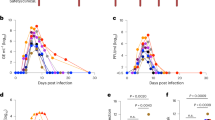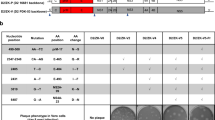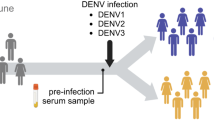Abstract
Dengue virus (DENV) is a human pathogen that causes severe and potentially fatal disease in millions of individuals each year. Immune-mediated pathology is thought to underlie many of the complications of DENV infection in humans, but the notable limitations of the available animal models have impeded our knowledge of the interactions between DENV and the immune system. In this Opinion article, we discuss some of the controversies in the field of dengue research relating to the interaction between DENV and the mammalian host. We highlight key barriers hindering our understanding of the molecular pathogenesis of DENV and offer suggestions for the most effective ways in which the role of the immune system in the protection from, and pathology of, DENV infection can be addressed experimentally.
This is a preview of subscription content, access via your institution
Access options
Subscribe to this journal
Receive 12 print issues and online access
$209.00 per year
only $17.42 per issue
Buy this article
- Purchase on Springer Link
- Instant access to full article PDF
Prices may be subject to local taxes which are calculated during checkout


Similar content being viewed by others
References
Gubler, D. J. Dengue, urbanization and globalization: the unholy trinity of the 21st century. Trop. Med. Health 39, 3–11 (2011).
Gubler, D. J. Dengue and dengue hemorrhagic fever. Clin. Microbiol. Rev. 11, 480–496 (1998).
Wilder-Smith, A. et al. DengueTools: innovative tools and strategies for the surveillance and control of dengue. Glob. Health Action 5, 17273 (2012).
Siler, J. F., Hall, M. W. & Hitchens, A. P. Results obtained in the transmission of dengue fever. JAMA 84, 1163–1172 (1925).
Sabin, A. B. Research on dengue during World War II. Am. J. Trop. Med. Hyg. 1, 30–50 (1952).
Aggarwal, A., Chandra, J., Aneja, S., Patwari, A. K. & Dutta, A. K. An epidemic of dengue hemorrhagic fever and dengue shock syndrome in children in Delhi. Indian Pediatr. 35, 727–732 (1998).
Vaughn, D. W. et al. Dengue viremia titer, antibody response pattern, and virus serotype correlate with disease severity. J. Infect. Dis. 181, 2–9 (2000).
Bhamarapravati, N., Tuchinda, P. & Boonyapaknavik, V. Pathology of Thailand haemorrhagic fever: a study of 100 autopsy cases. Ann. Trop. Med. Parasitol. 61, 500–510 (1967).
Zompi, S., Montoya, M., Pohl, M. O., Balmaseda, A. & Harris, E. Dominant cross-reactive B cell response during secondary acute dengue virus infection in humans. PLoS Negl. Trop. Dis. 6, e1568 (2012).
Steel, A., Gubler, D. J. & Bennett, S. N. Natural attenuation of dengue virus type-2 after a series of island outbreaks: a retrospective phylogenetic study of events in the South Pacific three decades ago. Virology 405, 505–512 (2010).
Messer, W. B., Gubler, D. J., Harris, E., Sivananthan, K. & de Silva, A. M. Emergence and global spread of a dengue serotype 3, subtype III virus. Emerg. Infect. Dis. 9, 800–809 (2003).
Vejbaesya, S. et al. TNF and LTA gene, allele, and extended HLA haplotype associations with severe dengue virus infection in ethnic Thais. J. Infect. Dis. 199, 1442–1448 (2009).
Chen, R. F. et al. Combination of CTLA-4 and TGFβ1 gene polymorphisms associated with dengue hemorrhagic fever and virus load in a dengue-2 outbreak. Clin. Immunol. 131, 404–409 (2009).
de la, C. S. B., Kouri, G. & Guzman, M. G. Race: a risk factor for dengue hemorrhagic fever. Arch. Virol. 152, 533–542 (2007).
Wu, S. J. et al. Human skin Langerhans cells are targets of dengue virus infection. Nature Med. 6, 816–820 (2000).
St John, A. L. et al. Immune surveillance by mast cells during dengue infection promotes natural killer (NK) and NKT-cell recruitment and viral clearance. Proc. Natl Acad. Sci. USA 108, 9190–9195 (2011).
Tassaneetrithep, B. et al. DC-SIGN (CD209) mediates dengue virus infection of human dendritic cells. J. Exp. Med. 197, 823–829 (2003).
Miller, J. L. et al. The mannose receptor mediates dengue virus infection of macrophages. PLoS Pathog. 4, e17 (2008).
Marchette, N. J. et al. Studies on the pathogenesis of dengue infection in monkeys. 3. Sequential distribution of virus in primary and heterologous infections. J. Infect. Dis. 128, 23–30 (1973).
St John, A. L., Rathore, A. P., Raghavan, B., Ng, M. L. & Abraham, S. N. Contributions of mast cells and vasoactive products, leukotrienes and chymase, to dengue virus-induced vascular leakage. eLife (in the press).
Rothman, A. L. Immunity to dengue virus: a tale of original antigenic sin and tropical cytokine storms. Nature Rev. Immunol. 11, 532–543 (2011).
Wang, T. et al. IFN-γ-producing γδ T cells help control murine West Nile virus infection. J. Immunol. 171, 2524–2531 (2003).
Starnes, T. et al. Cutting edge: IL-17F, a novel cytokine selectively expressed in activated T cells and monocytes, regulates angiogenesis and endothelial cell cytokine production. J. Immunol. 167, 4137–4140 (2001).
Tsai, Y. T., Chang, S. Y., Lee, C. N. & Kao, C. L. Human TLR3 recognizes dengue virus and modulates viral replication in vitro. Cell. Microbiol. 11, 604–615 (2009).
Loo, Y. M. et al. Distinct RIG-I and MDA5 signaling by RNA viruses in innate immunity. J. Virol. 82, 335–345 (2008).
Halstead, S. B. Antibody, macrophages, dengue virus infection, shock, and hemorrhage: a pathogenetic cascade. Rev. Infect. Dis. 11 (Suppl. 4), S830–S839 (1989).
Halstead, S. B. Dengue. Lancet 370, 1644–1652 (2007).
Gubler, D. J. & Zaki, S. in Pathology of Emerging Infections 2 Ch. 3 (eds Nelson, A. M. & Horsburgh, C. R.) 43–71 (American Society for Microbiology Press, 1998).
Zellweger, R. M., Prestwood, T. R. & Shresta, S. Enhanced infection of liver sinusoidal endothelial cells in a mouse model of antibody-induced severe dengue disease. Cell Host Microbe 7, 128–139 (2010).
Jessie, K., Fong, M. Y., Devi, S., Lam, S. K. & Wong, K. T. Localization of dengue virus in naturally infected human tissues, by immunohistochemistry and in situ hybridization. J. Infect. Dis. 189, 1411–1418 (2004).
Halstead, S. B. Controversies in dengue pathogenesis. Paediatr. Int. Child Health 32 (Suppl. 1), 5–9 (2012).
Hober, D. et al. Serum levels of tumor necrosis factor-alpha (TNF-α), interleukin-6 (IL-6), and interleukin-1β (IL-1β) in dengue-infected patients. Am. J. Trop. Med. Hyg. 48, 324–331 (1993).
Edwards, M. J., Heniford, B. T. & Miller, F. N. Tumor necrosis factor mediates disseminated intravascular inflammation (DII) in the genesis of multiple organ edema. J. Surg. Res. 54, 140–144 (1993).
Kunder, C. A., St John, A. L. & Abraham, S. N. Mast cell modulation of the vascular and lymphatic endothelium. Blood 118, 5383–5393 (2011).
Wang, L. et al. Implications of dynamic changes among tumor necrosis factor-α (TNF-α), membrane TNF receptor, and soluble TNF receptor levels in regard to the severity of dengue infection. Am. J. Trop. Med. Hyg. 77, 297–302 (2007).
Chakravarti, A. & Kumaria, R. Circulating levels of tumour necrosis factor-α and interferon-γ in patients with dengue and dengue haemorrhagic fever during an outbreak. Indian J. Med. Res. 123, 25–30 (2006).
Halstead, S. B. et al. Dengue hemorrhagic fever in infants: research opportunities ignored. Emerg. Infect. Dis. 8, 1474–1479 (2002).
Kliks, S. C., Nimmanitya, S., Nisalak, A. & Burke, D. S. Evidence that maternal dengue antibodies are important in the development of dengue hemorrhagic fever in infants. Am. J. Trop. Med. Hyg. 38, 411–419 (1988).
Hawkes, R. A. Enhancement of the infectivity of Arboviruses by specific antisera produced in domestic fowls. Aust. J. Exp. Biol. Med. Sci. 42, 465–482 (1964).
Goncalvez, A. P., Engle, R. E., St Claire, M., Purcell, R. H. & Lai, C. J. Monoclonal antibody-mediated enhancement of dengue virus infection in vitro and in vivo and strategies for prevention. Proc. Natl Acad. Sci. USA 104, 9422–9427 (2007).
Daughaday, C. C., Brandt, W. E., McCown, J. M. & Russell, P. K. Evidence for two mechanisms of dengue virus infection of adherent human monocytes: trypsin-sensitive virus receptors and trypsin-resistant immune complex receptors. Infect. Immun. 32, 469–473 (1981).
Halstead, S. B., Chow, J. S. & Marchette, N. J. Immunological enhancement of dengue virus replication. Nature New Biol. 243, 24–26 (1973).
Halstead, S. B. & O'Rourke, E. J. Antibody-enhanced dengue virus infection in primate leukocytes. Nature 265, 739–741 (1977).
Halstead, S. B., Venkateshan, C. N., Gentry, M. K. & Larsen, L. K. Heterogeneity of infection enhancement of dengue 2 strains by monoclonal antibodies. J. Immunol. 132, 1529–1532 (1984).
Webster, R. G. Original antigenic sin in ferrets: the response to sequential infections with influenza viruses. J. Immunol. 97, 177–183 (1966).
Mongkolsapaya, J. et al. Original antigenic sin and apoptosis in the pathogenesis of dengue hemorrhagic fever. Nature Med. 9, 921–927 (2003).
Halstead, S. B., Rojanasuphot, S. & Sangkawibha, N. Original antigenic sin in dengue. Am. J. Trop. Med. Hyg. 32, 154–156 (1983).
Singh, R. A., Rodgers, J. R. & Barry, M. A. The role of T cell antagonism and original antigenic sin in genetic immunization. J. Immunol. 169, 6779–6786 (2002).
Gubler, D. J., Reed, D., Rosen, L. & Hitchcock, J. R. Jr. Epidemiologic, clinical, and virologic observations on dengue in the Kingdom of Tonga. Am. J. Trop. Med. Hyg. 27, 581–589 (1978).
Vaughn, D. W. et al. Dengue in the early febrile phase: viremia and antibody responses. J. Infect. Dis. 176, 322–330 (1997).
Kliks, S. C., Nisalak, A., Brandt, W. E., Wahl, L. & Burke, D. S. Antibody-dependent enhancement of dengue virus growth in human monocytes as a risk factor for dengue hemorrhagic fever. Am. J. Trop. Med. Hyg. 40, 444–451 (1989).
Meltzer, E., Heyman, Z., Bin, H. & Schwartz, E. Capillary leakage in travelers with dengue infection: implications for pathogenesis. Am. J. Trop. Med. Hyg. 86, 536–539 (2012).
Balsitis, S. J. et al. Lethal antibody enhancement of dengue disease in mice is prevented by Fc modification. PLoS Pathog. 6, e1000790 (2010).
Shresta, S., Sharar, K. L., Prigozhin, D. M., Beatty, P. R. & Harris, E. Murine model for dengue virus-induced lethal disease with increased vascular permeability. J. Virol. 80, 10208–10217 (2006).
de Borba, L., Strottmann, D. M., de Noronha, L., Mason, P. W. & Dos Santos, C. N. Synergistic interactions between the NS3hel and E proteins contribute to the virulence of dengue virus type 1. PLoS Negl Trop. Dis. 6, e1624 (2012).
Avirutnan, P. et al. Antagonism of the complement component C4 by flavivirus nonstructural protein NS1. J. Exp. Med. 207, 793–806 (2010).
Ashour, J. et al. Mouse STAT2 restricts early dengue virus replication. Cell Host Microbe 8, 410–421 (2010).
Kochel, T. J. et al. Effect of dengue-1 antibodies on American dengue-2 viral infection and dengue haemorrhagic fever. Lancet 360, 310–312 (2002).
Bennett, S. N. et al. Selection-driven evolution of emergent dengue virus. Mol. Biol. Evol. 20, 1650–1658 (2003).
Zivna, I. et al. T cell responses to an HLA-B*07-restricted epitope on the dengue NS3 protein correlate with disease severity. J. Immunol. 168, 5959–5965 (2002).
Chiewsilp, P., Scott, R. M. & Bhamarapravati, N. Histocompatibility antigens and dengue hemorrhagic fever. Am. J. Trop. Med. Hyg. 30, 1100–1105 (1981).
Loke, H. et al. Strong HLA class I–restricted T cell responses in dengue hemorrhagic fever: a double-edged sword? J. Infect. Dis. 184, 1369–1373 (2001).
Fernandez-Mestre, M. T., Gendzekhadze, K., Rivas-Vetencourt, P. & Layrisse, Z. TNF-α-308A allele, a possible severity risk factor of hemorrhagic manifestation in dengue fever patients. Tissue Antigens 64, 469–472 (2004).
Soundravally, R. & Hoti, S. L. Polymorphisms of the TAP 1 and 2 gene may influence clinical outcome of primary dengue viral infection. Scand. J. Immunol. 67, 618–625 (2008).
Cassetti, M. C. et al. Report of an NIAID workshop on dengue animal models. Vaccine 28, 4229–4234 (2010).
Onlamoon, N. et al. Dengue virus-induced hemorrhage in a nonhuman primate model. Blood 115, 1823–1834 (2010).
Halstead, S. B., Shotwell, H. & Casals, J. Studies on the pathogenesis of dengue infection in monkeys. I. Clinical laboratory responses to primary infection. J. Infect. Dis. 128, 7–14 (1973).
Omatsu, T. et al. Common marmoset (Callithrix jacchus) as a primate model of dengue virus infection: development of high levels of viraemia and demonstration of protective immunity. J. Gen. Virol. 92, 2272–2280 (2011).
Guirakhoo, F. et al. A single amino acid substitution in the envelope protein of chimeric yellow fever-dengue 1 vaccine virus reduces neurovirulence for suckling mice and viremia/viscerotropism for monkeys. J. Virol. 78, 9998–10008 (2004).
Bente, D. A. & Rico-Hesse, R. Models of dengue virus infection. Drug Discov. Today Dis. Models 3, 97–103 (2006).
Yauch, L. E. & Shresta, S. Mouse models of dengue virus infection and disease. Antiviral Res. 80, 87–93 (2008).
Simmons, J. S., St. John, J. H., & Reynolds, H. K. Experimental Studies of Dengue (Bureau of Printing, Manila, 1931).
Rathore, A. P. et al. Celgosivir treatment misfolds dengue virus NS1 protein, induces cellular pro-survival genes and protects against lethal challenge mouse model. Antiviral Res. 92, 453–460 (2011).
Watts, D. M. et al. Failure of secondary infection with American genotype dengue 2 to cause dengue haemorrhagic fever. Lancet 354, 1431–1434 (1999).
Thein, S. et al. Risk factors in dengue shock syndrome. Am. J. Trop. Med. Hyg. 56, 566–572 (1997).
Vitarana, T., de Silva, H., Withana, N. & Gunasekera, C. Elevated tumour necrosis factor in dengue fever and dengue haemorrhagic fever. Ceylon Med. J. 36, 63–65 (1991).
Wahala, W. M., Huang, C., Butrapet, S., White, L. J. & de Silva, A. M. Recombinant dengue type 2 viruses with altered e protein domain III epitopes are efficiently neutralized by human immune sera. J. Virol. 86, 4019–4023 (2012).
Acknowledgements
The authors thank A. P. S. Rathore for critical reading of the manuscript. This work was supported by the National Medical Research Council of Singapore (grant NIG/1053/2011) and by the Duke-National University of Singapore Signature Research Program, funded by the Ministry of Health, Singapore.
Author information
Authors and Affiliations
Corresponding author
Ethics declarations
Competing interests
The authors declare no competing financial interests.
Related links
FURTHER INFORMATION
Rights and permissions
About this article
Cite this article
St. John, A., Abraham, S. & Gubler, D. Barriers to preclinical investigations of anti-dengue immunity and dengue pathogenesis. Nat Rev Microbiol 11, 420–426 (2013). https://doi.org/10.1038/nrmicro3030
Published:
Issue Date:
DOI: https://doi.org/10.1038/nrmicro3030
This article is cited by
-
Mechanism of autophagy induced by activation of the AMPK/ERK/mTOR signaling pathway after TRIM22-mediated DENV-2 infection of HUVECs
Virology Journal (2022)
-
A mosquito salivary protein promotes flavivirus transmission by activation of autophagy
Nature Communications (2020)
-
Serum chymase levels correlate with severe dengue warning signs and clinical fluid accumulation in hospitalized pediatric patients
Scientific Reports (2020)
-
Chimeric flavivirus enables evaluation of antibodies against dengue virus envelope protein in vitro and in vivo
Scientific Reports (2020)
-
Adaptive immune responses to primary and secondary dengue virus infections
Nature Reviews Immunology (2019)



